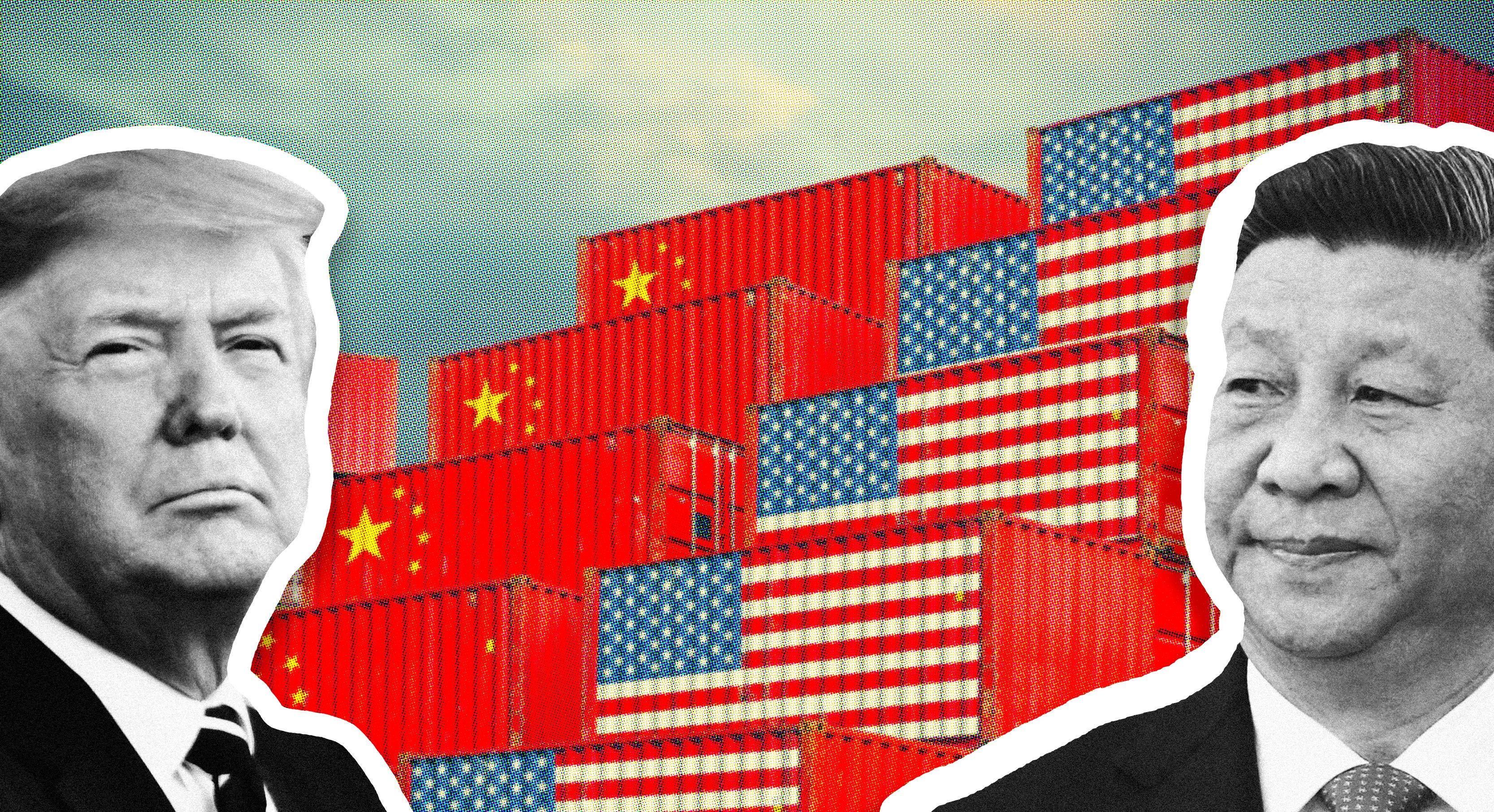Tariff Turbulence: How Trump's Trade War Reshaped The Tech Industry

Table of Contents
Rising Prices and Consumer Impact
Trump's trade war directly translated into higher prices for consumers. The imposition of tariffs on imported tech components, such as microchips, displays, and rare earth minerals, significantly increased the cost of manufacturing finished goods. This increase wasn't absorbed by companies; instead, it was passed on to consumers, resulting in a noticeable price hike for a wide range of electronics.
- Increased prices for smartphones, laptops, and other electronics: Tariffs led to a 10-20% increase in the price of many popular electronics, depending on the proportion of imported components. This price increase was particularly noticeable for products heavily reliant on Chinese manufacturing.
- Reduced consumer purchasing power: Higher prices led to decreased consumer demand, impacting sales for tech companies of all sizes. Consumers faced difficult choices, delaying purchases or opting for cheaper, potentially lower-quality alternatives.
- Impact on smaller tech companies with less pricing flexibility: Smaller companies, with thinner profit margins, were disproportionately affected. They had less ability to absorb increased costs without significantly impacting their profitability or competitiveness.
- Shift in consumer demand towards domestically produced (or less tariff-affected) alternatives: The price increases spurred some consumers to seek out domestically manufactured products or those sourced from countries unaffected by the tariffs. This shift, while not massive, created opportunities for some domestic producers.
Disrupted Supply Chains and Manufacturing Shifts
The intricate global supply chains that underpin the tech industry were severely disrupted by Trump's trade war. Companies heavily reliant on components sourced from China faced significant challenges, including extended lead times and increased production costs.
- Increased lead times for production: The delays in obtaining components, coupled with increased bureaucratic hurdles, caused significant production delays, impacting product launches and sales forecasts.
- Companies relocating manufacturing facilities to avoid tariffs: To mitigate the impact of tariffs, many companies initiated "reshoring" (returning manufacturing to the US) or "nearshoring" (moving manufacturing to nearby countries) strategies. This involved significant capital investment and logistical complexities.
- The rise of reshoring and nearshoring strategies: This shift represented a fundamental change in global manufacturing strategies, with companies prioritizing diversification and reducing dependence on single-source suppliers.
- Increased costs associated with diversifying supply chains: Diversifying supply chains involved substantial costs, including setting up new manufacturing facilities, training new workforces, and navigating new regulatory landscapes.
Impact on Innovation and Technological Advancement
The trade war's impact extended beyond pricing and supply chains; it also affected the crucial area of innovation and technological advancement.
- Reduced cross-border collaborations in research and development: Tariffs and trade tensions created an atmosphere of uncertainty, hindering collaborative research projects between US and Chinese companies. This limited the exchange of ideas and expertise.
- Increased barriers to entry for smaller tech companies: Smaller companies, with fewer resources to navigate complex trade regulations and absorb increased costs, faced significantly higher barriers to entry into the market.
- Potential for slowing down technological advancements due to disrupted supply chains: Disruptions to global supply chains created bottlenecks that potentially slowed down the pace of technological innovation, as companies struggled to acquire the necessary components for product development.
- Focus on domestic innovation as a response to trade barriers: The trade war prompted some investment in domestic research and development, aiming to reduce reliance on foreign suppliers and build a more resilient technological ecosystem.
Geopolitical Ramifications and Global Competitiveness
Trump's trade war had far-reaching geopolitical implications, fundamentally altering the dynamics of global tech competition.
- Strained US-China relations in the tech sector: The trade war exacerbated existing tensions between the US and China, creating a more adversarial environment in the technology sector. This impacted everything from technology licensing to intellectual property rights.
- Increased protectionist measures globally: The trade war spurred other countries to adopt protectionist measures, further fragmenting the global tech market and creating uncertainty for businesses operating across borders.
- Shift in global tech dominance: The trade war potentially accelerated a shift in global tech dominance, as companies from other regions stepped in to fill gaps left by disruptions in the US-China trade relationship.
- Impact on international standards and regulations: The trade war underscored the importance of international cooperation in setting technology standards and regulations, highlighting the need for a more multilateral approach.
Conclusion
Trump's trade war left an indelible mark on the tech industry. The resulting tariff turbulence led to significantly higher prices for consumers, severely disrupted global supply chains, impacted innovation and technological advancement, and altered the geopolitical landscape of global tech competition. Understanding the lasting effects of Trump's trade war is crucial for navigating the complexities of the global tech market. Further research into the long-term implications of these trade policies is needed to better prepare for future economic uncertainty. For more information on the ongoing effects of trade policies on global industries, explore resources from organizations like the World Trade Organization (WTO) and the Peterson Institute for International Economics.

Featured Posts
-
 Keeping Key Roads Open A Realistic Assessment For Tasman
May 13, 2025
Keeping Key Roads Open A Realistic Assessment For Tasman
May 13, 2025 -
 April 26th Mlb Baseball Home Run Prop Bets And Analysis
May 13, 2025
April 26th Mlb Baseball Home Run Prop Bets And Analysis
May 13, 2025 -
 Watch Premier League Retro On Sky Sports Hd Quality Football
May 13, 2025
Watch Premier League Retro On Sky Sports Hd Quality Football
May 13, 2025 -
 La And Orange Counties Sizzle Under Record Breaking Heat Extreme Temperatures And Safety Tips
May 13, 2025
La And Orange Counties Sizzle Under Record Breaking Heat Extreme Temperatures And Safety Tips
May 13, 2025 -
 Sigue El Partido Atalanta Vs Bologna Serie A Fecha 32 Transmision En Vivo
May 13, 2025
Sigue El Partido Atalanta Vs Bologna Serie A Fecha 32 Transmision En Vivo
May 13, 2025
Latest Posts
-
 The How To Train Your Dragon Remakes Almost Controversial Decision
May 13, 2025
The How To Train Your Dragon Remakes Almost Controversial Decision
May 13, 2025 -
 Serie A 2025 Atalanta Vs Lazio Transmision En Vivo Y Horarios
May 13, 2025
Serie A 2025 Atalanta Vs Lazio Transmision En Vivo Y Horarios
May 13, 2025 -
 How To Train Your Dragon Live Action Near Miss With A Controversial Choice
May 13, 2025
How To Train Your Dragon Live Action Near Miss With A Controversial Choice
May 13, 2025 -
 Donde Ver Atalanta Vs Lazio En Vivo Serie A 2025
May 13, 2025
Donde Ver Atalanta Vs Lazio En Vivo Serie A 2025
May 13, 2025 -
 How Close Did The How To Train Your Dragon Live Action Remake Come To A Controversial Decision
May 13, 2025
How Close Did The How To Train Your Dragon Live Action Remake Come To A Controversial Decision
May 13, 2025
